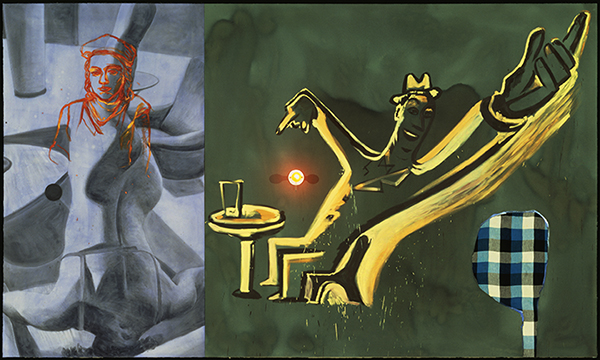At the Parrish Art Museum
By Sandra Tyler, Editor-in-Chief
Unfinished Business: Paintings from the 1970s and 1980s by Ross Bleckner, Eric Fischl, and David Salle is a grouping of three artists who were friends for decades, and all who wound up on the east end of Long Island where the Parrish is located. But their similarities are also deeply rooted in their actual works; each artist addressed the changing cultural and social landscape between 1976 -1987. And they seemed to have clearly influenced each other, not only via their shared values but actual color choices.
This of course, is all of interest, but so is how exactly their works are as much diverse as they might be similar. All three may have tackled the same themes, and even shared a similar palette, but their results are unique unto each artist. As David Pagel, Parrish adjust curator and exhibition organizer, states, “Bleckner, Fischl, and Salle found in paint a medium they could turn to for their own purposes.”
Bleckner’s paintings stand apart as they are by far the most abstract, and some handled with an astounding subtlety–an oxymoron perhaps, but it is a subtlety that can surprise. “Painting for Sleep and Escape” is carefully gradated shades of purple and black activated by by the more concise of geometric shapes:

This “oxymoron” is quintessentially apparent in “The Forest”, a canvas of truly vibrant parallel lines up close, but lines that blend into the more nuanced from a distance:

In the works of Salle and Fischl the figurative predominates, though abstraction seemed to be of of some focus for Salle as well. In “The Truck Brings Things” the loosely illustrative is contrasted against bold shapes and colors, even a checkered pattern:

oil and acrylic on canvas with light bulb and fabric
102 x 173.25 inches
Fischl’s works, the least abstract and most figurative, perhaps most obviously resonate of social and cultural connotations, and often in suburban settings. But as much as these connotations may leave these paintings wide open to the thought provoking, it is his compositions that energize these powerful narrative paintings. In “Master Bedroom” the girl on the bed with the dog might seem static if not for the dynamic shapes of the white set against the back horizontal of the bed and even darker plane of the floor:

This kinetic synergy between subject and setting in “Haircut” nearly screams– strong vertical lines are sharply broken up by their antithesis, the woman’s curves and the pronounced circular shape of the mirror, also the only cool color in the painting:

This show is up only through October 16th, but it is in conjunction with a permanent collection installation that is up through November, Collective Conversations, featuring Dan Flavin, Mel Kendrick, Dorothea Rockburne, and Keith Sonnier; and Connections and Context with Dan Chrstiensen, Frieden Dzubas, Helen Frankenthaler and Ellsworth Kelly — all of whom lived and worked on the East End, and as well, influenced each other’s careers.
The Parrish museum is a Long island highlight worth visiting no matter what the exhibition. Inspired by the natural setting and artistic life of Long Island’s East End, the museum is set in an open field, wild with native grasses and flowers:

Next up is Artists Choose Artists, the Parrish Art Museum’s juried exhibition open to artists working in all media and living on the East End of Long Island.

